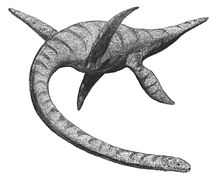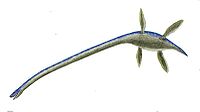- Plesiosauria
-
Plesiosauria
Temporal range: Early Jurassic - Late Cretaceous, 199.6–65.5 Ma
Artist's reconstruction of Plesiosaurus. Scientific classification 
Kingdom: Animalia Phylum: Chordata Class: Reptilia Superorder: †Sauropterygia Node: †Pistosauria Order: †Plesiosauria
de Blainville, 1835Suborders Plesiosauroidea
PliosauroideaPlesiosauria (
 /ˌpliːsi.ɵˈsɔriə/; Greek: plesios meaning 'near to' and sauros meaning 'lizard') is an order of Mesozoic marine reptiles. Plesiosaurs first appeared in the Early Jurassic (and possibly Rhaetian, latest Triassic) Period and became especially common during the Jurassic Period, thriving until the K-T extinction at the end of the Cretaceous Period.
/ˌpliːsi.ɵˈsɔriə/; Greek: plesios meaning 'near to' and sauros meaning 'lizard') is an order of Mesozoic marine reptiles. Plesiosaurs first appeared in the Early Jurassic (and possibly Rhaetian, latest Triassic) Period and became especially common during the Jurassic Period, thriving until the K-T extinction at the end of the Cretaceous Period.The name "plesiosaur" is used to refer to the order Plesiosauria as a whole, but not to the long-necked forms (suborder Plesiosauroidea) only. These latter constitute the plesiosaurs in the popular imagination ("Nessie").
Contents
Description
The typical plesiosaur had a broad body and a short tail. They retained their ancestral two pairs of limbs, which evolved into large flippers. Plesiosaurs evolved from the earlier nothosaurs, who had a more crocodile-like body; major types of plesiosaur are primarily distinguished by head and neck size. Members of Plesiosauroidea such as Cryptoclididae, Elasmosauridae and Plesiosauridae had long necks and may have been 'bottom-feeders', in shallow waters. Most pliosaurs and rhomaleosaurs, however, had shorter necks with a large, elongated head and may have been at home in deeper waters.
All plesiosaurs had four paddle-shaped 'flipper' limbs. This is an unusual arrangement in aquatic animals and it is thought that they were used to propel the animal through the water by a combination of rowing movements and up-and-down movements. There appears to have been no tail fin and the tail was most likely used for helping in directional control. This arrangement is in contrast to that of the later mosasaurs and the earlier ichthyosaurs. There may be similarities with the method of swimming used by penguins and turtles, which respectively have two and four flipper-like limbs.
In general, the plesiosaurians are among the largest marine predators of all time, with the smallest about 2 m (6.5 ft) long. The largest pliosaurs were up to 15 m long. Plesiosaurs grew even longer; Mauisaurus was 20 meters long. However, the late Triassic ichthyosaurs, such as shastasaurids are known to have reached 21 m in length. Modern large marine animals such as the sperm whale (20 m), and especially the blue whale (~30 m) all grew larger than currently known plesiosaurians.
The anteriorly placed internal nostrils have palatal grooves to channel water, the flow of which would be maintained by hydrodynamic pressure over the posteriorly placed external nares during locomotion. During its passage through the nasal ducts, the water would have been 'tasted' by olfactory epithelia[citation needed].
History of discovery
Mary Anning (1799–1847) was famous for her plesiosaur discoveries at Lyme Regis in Dorset, UK. She is credited with the first plesiosaur find (Plesiosaurus dolichodeirus), which has become the 'type fossil' (genoholotype). This region of Britain is now a World Heritage Site, dubbed the Jurassic Coast.
Recent discoveries
In 2002, the "Monster of Aramberri" was announced to the press. Discovered in 1982 at the village of Aramberri, in the northern Mexican state of Nuevo León, it was originally classified as a dinosaur. The specimen is actually a very large plesiosaur, possibly reaching 15 m (50 ft) in length. The media published exaggerated reports claiming it was 25 m (80 ft) long, and weighed up to 150,000 kg, which would have made it the largest predator of all time. This error was dramatically perpetuated in BBC's documentary series Walking with Dinosaurs, which also prematurely classified it as a Liopleurodon ferox.
In 2004, what appears to be a completely intact juvenile plesiosaur was discovered, by a local fisherman at Bridgwater Bay National Nature Reserve in Somerset, UK. The fossil, dated 180 My by the ammonites associated with it, measures 1.5 m (5 ft) in length, and may be related to Rhomaleosaurus. It is probably the best preserved specimen of a plesiosaur yet discovered[citation needed].
Behavior
 Painting of a plesiosaur on land, by Heinrich Harder
Painting of a plesiosaur on land, by Heinrich Harder
Plesiosaurs have been discovered with fossils of belemnites (squid-like animals), and ammonites (giant nautilus-like molluscs) associated with their stomachs[citation needed]. They had powerful jaws, probably strong enough to bite through the hard shells of their prey. The bony fish (Osteichthyes), started to spread in the Jurassic, and were likely prey as well. Recent evidence seems to indicate that some plesiosaurs may have, in fact, been bottom feeders.[1]
It had been theorised that smaller plesiosaurs may have crawled up on a beach to lay their eggs, like the modern leatherback turtle, but it is now clear plesiosaurs gave birth to live young [2]: The fossil of a pregnant plesiosaur Polycotylus latippinus shows that these animals gave birth to one large juvenile and probably invested parental care in their offspring, similar to modern whales.[3]
Another curiosity is their four-flippered design. No modern animals have this swimming adaptation (sea turtles only swim with their front flippers), so there is considerable speculation about what kind of stroke they used. While the short-necked pliosauroids (e.g. Liopleurodon) may have been fast swimmers, the long-necked varieties were built more for maneuverability than for speed. Skeletons have also been discovered with gastroliths in their stomachs, though whether to help break down food in a muscular gizzard, or to help with buoyancy has not been established.
Classification
Taxonomy
 Kronosaurus, a pliosaurid
Kronosaurus, a pliosaurid
 Thalassomedon, an elasmosaurid
Thalassomedon, an elasmosaurid
 Dolichorhynchops, a polycotylid
Dolichorhynchops, a polycotylid
The taxonomy presented here is mainly based on the plesiosaur cladistic analysis proposed by Hilary F. Ketchum and Roger B. J. Benson, 2011 unless otherwise noted.[4]
- Node Pistosauria
- Augustasaurus
- Bobosaurus
- Pistosaurus
- Yunguisaurus
- Order Plesiosauria
- Suborder Plesiosauroidea
- Family Elasmosauridae
- Family Plesiosauridae
- Node Cryptoclidia
- ? Family Aristonectidae
- Family Cryptoclididae
- Node Leptocleidia
- Family Leptocleididae
- Family Polycotylidae
- Suborder Pliosauroidea
- Family Rhomaleosauridae
- Family Pliosauridae
- Suborder Plesiosauroidea
Phylogeny
Plesiosauria is a stem-based taxon which was defined as "all taxa more closely related to Plesiosaurus dolichodeirus and Pliosaurus brachydeirus than to Augustasaurus hagdorni". Neoplesiosauria is a node-based taxon which was defined by Ketchum and Benson (2011) as "Plesiosaurus dolichodeirus, Pliosaurus brachydeirus, their most recent common ancestor and all of its descendants".[5] Therefore, Neoplesiosauria is currently a junior synonym of Plesiosauria, as a non-pliosauroid, non-plesiosauroid plesiosaur is yet to be discovered. The following cladogram follows an analysis by Ketchum & Benson, 2011:[4]
Pistosauria "Pistosaurus postcranium"
Bobosaurus
Yunguisaurus
Plesiosauria Plesiosauroidea
Pliosauroidea
Distribution
Stratigraphic distribution
The following is a list of geologic formations that have produced plesiosaur fossils.
Click [show] to view a table of geologic formationsName Age Location Notes Allen Formation
Mata Amarilla Formation
Jagüel Formation
Blue Lias Formation
Britton Formation
Carlile Formation
Favret Formation
Franciscan Formation
Guanling Formation
Hiccles Cove Formation
Jagua Formation
Katiki Formation
Kiowa Shale
Lake Waco Formation
The following genera have been reported from the formation: Brimosaurus,[6] Dolichorhynchops,[7] Elasmosaurus,[7] Polycotylus,[7] Styxosaurus,[7] and Thalassonomosaurus.[8]
Paja Formation
Paso del Sapo Formation
Pierre Formation
Sundance Formation
Tahora Formation
Tamayama Formation
Toolebuc Formation
Vectis Formation
Wallumbilla Formation
Zhenzhuchong Formation
Ziliujing Formation
References
- ^ BBC NEWS | Science/Nature | Plesiosaur bottom-feeding shown
- ^ O'Keefe, F.R. and Chiappe, L.M. (2011): Viviparity and K-Selected Life History in a Mesozoic Marine Plesiosaur (Reptilia, Sauropterygia). Science, 333 (6044): 870-873 doi:10.1126/science.1205689
- ^ http://www.livescience.com/15517-pregnant-plesiosaur-big-live-young.html
- ^ a b Hilary F. Ketchum and Roger B. J. Benson (2011). "A new pliosaurid (Sauropterygia, Plesiosauria) from the Oxford Clay Formation (Middle Jurassic, Callovian) of England: evidence for a gracile, longirostrine grade of Early-Middle Jurassic pliosaurids". Special Papers in Palaeontology 86: 109-129. doi:10.1111/j.1475-4983.2011.01083.x.
- ^ Ketchum, H.F.; Benson, R.B.J. (2010). "Global interrelationships of Plesiosauria (Reptilia, Sauropterygia) and the pivotal role of taxon sampling in determining the outcome of phylogenetic analyses.". Biological Reviews of the Cambridge Philosophical Society 85 (2): 361–392. doi:10.1111/j.1469-185X.2009.00107.x. PMID 20002391.
- ^ "Material: YPM 1640," in "The Occurence of Elasmosaurids..." Everhart (2006), page 173.
- ^ a b c d "Table 13.1: Plesiosaurs," in Everhart (2005) Oceans of Kansas, page 245.
- ^ "Material: YPM 1640," in "The Occurence of Elasmosaurids..." Everhart (2006), page 172.
- Lingham-Soliar, T., 1995: in Phil. Trans. Roy. Soc. Lond. 347: 155-180
- Cicimurri, D., and M. Everhart, 2001: in Trans. Kansas. Acad. Sci. 104: 129-143
- O'Keefe, F. R., 2001: A cladistic analysis and taxonomic revision of the Plesiosauria (Reptilia: Sauropterygia); Acta Zool. Fennica 213: 1-63
- White, T., 1935: in Occasional Papers Boston Soc. Nat. Hist. 8: 219-228
- Hampe, O., 1992: Courier Forsch.-Inst. Senckenberg 145: 1-32
- Ellis, R. 2003: Sea Dragons' (Kansas University Press)
- ( ), 1997: in Reports of the National Center for Science Education, 17.3 (May/June 1997) pp 16–28.
- Everhart, M.J. 2005. Oceans of Kansas: A Natural History of the Western Interior Sea. Indiana University Press, Bloomington, 322 pp.
- Everhart, M.J. 2005. "Gastroliths associated with plesiosaur remains in the Sharon Springs Member (Late Cretaceous) of the Pierre Shale, Western Kansas" (on-line, updated from article in Kansas Acad. Sci. Trans. 103(1-2):58-69)
- Everhart, Michael J. 2006. The Occurrence of Elasmosaurids (Reptilia: Plesiosauria) in the Niobrara Chalk of Western Kansas; Paludicila; 5(4) pp. 170–183
External links
- The Plesiosaur Site. Richard Forrest.
- The Plesiosaur Directory. Adam Stuart Smith.
- Plesiosauria technical definition at the Plesiosaur Directory
- Plesiosaur FAQ's. Raymond Thaddeus C. Ancog.
- Oceans of Kansas Paleontology. Mike Everhart.
- "Plesiosaur fossil found in Bridgwater Bay". Somersert Museums County Service. (best known fossil)
- "Fossil hunters turn up 50-ton monster of prehistoric deep". Allan Hall and Mark Henderson. Times Online, December 30, 2002. (Monster of Aramberri)
- Triassic reptiles had live young.
- Bridgwater Bay juvenile plesiosaur
Plesiosauria Major clades NeoplesiosauriaPliosauroideaPliosauridae · RhomaleosauridaeRelated cladesPlesiosauroidea PlesiosauridaeHydrorion · Lusonectes · Microcleidus · Occitanosaurus · Plesiosaurus · Seeleyosaurus · WestphaliasaurusAlexeyisaurus · Aphrosaurus · ?Aristonectes · Callawayasaurus · Cimoliasaurus · Elasmosaurus · Eromangasaurus · Fresnosaurus · Futabasaurus · Goniosaurus · Hydralmosaurus · Hydrotherosaurus · ?Kaiwhekea · Libonectes · Mauisaurus · Morenosaurus · Ogmodirus · Orophosaurus · Piptomerus · Styxosaurus · Terminonatator · Thalassomedon · Tuarangisaurus · Wapuskanectes · Woolungasaurus · ZarafasauraAristonectidaeColymbosaurus · Cryptoclidus · Kimmerosaurus · Muraenosaurus · Opallionectes · Pantosaurus · Scanisaurus · ?Tatenectes · VinialesaurusLeptocleidiaLeptocleididaeCeraumasaurus · Dolichorhynchops · Edgarosaurus · Eopolycotylus · Georgiasaurus · Manemergus · Pahasapasaurus · Palmulasaurus · Plesiopleurodon · Polycotylus · Procotylus · Sulcusuchus · Thililua · TrinacromerumOthersPliosauroidea RhomaleosauridaeArchaeonectrus · ?Bishanopliosaurus · Borealonectes · Eurycleidus · Macroplata · Maresaurus · Meyerasaurus · Rhomaleosaurus · Sthenarosaurus · YuzhoupliosaurusPliosauridaeAttenborosaurus · Hauffiosaurus · Kronosaurus · Liopleurodon · Marmornectes · Peloneustes · Pliosaurus · Polyptychodon · Simolestes · ThalassiodraconBrachaucheninaeOthersRelated articles and categories Plesiosaurs · List of plesiosaursCategories:- Plesiosaurs
- Node Pistosauria
Wikimedia Foundation. 2010.


